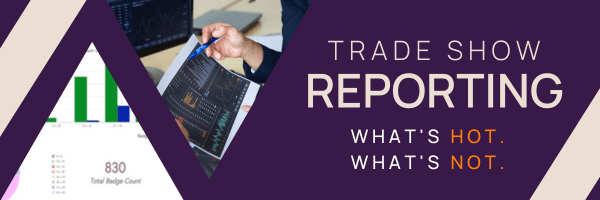In recent years, there have been significant advancements in trade show data reporting, with new technologies and tools emerging to help show organizers gain more insights and business intelligence (BI) from their trade show data. Events generate a vast amount of data to manage and analyze effectively. This data will continue to grow in importance to both internal and external audiences as events rebound from the pandemic.
It is particularly important for many exhibitors and sponsors as these companies invest a lot of resources, time, and effort into trade shows to generate leads, expand their networks, and boost their brand awareness. These organizations will seek ways to quantify and validate their investments with informed data.
This blog post will explore what’s hot and what’s not with trade show data reporting, including the latest trends and innovations.
HOT: Business Intelligence and Visualization Tools
One of the most significant trade show data reporting trends is the rise of business intelligence and visualization tools. These tools help businesses combine and analyze their trade show data from multiple sources, across years and events.
With these tools, businesses can gain a holistic view of their trade show performance and track their ROI more accurately. The data visualization features also make it easier for organizations to quickly interpret their data and identify trends and patterns and take action! Many organizers and event professionals are looking to adjust their event based on the data to maximize the opportunity for everyone involved.
NOT: Traditional Reporting Methods
Traditional trade show data reporting methods, such as spreadsheets and manual data entry, are less effective as trade shows become more complex and generate more data. These methods are time-consuming and prone to errors, making gaining meaningful insights from the data challenging.
HOT: Booth and Lead Analytics
Another emerging trend in trade show data is leveraging multiple sources of data to report on exhibitor and trade show floor engagement. By leveraging lead scan data in combination with floor plan map, show organizers can gain insights into which companies generated the most leads. Many times, this activity can showcase that size of booth and location may not at all impact the ability for an exhibitor to activate effectively at your event. This data, along with analytics collected from online profiles can help further showcase the value of the event.
Furthermore, this critical information can be a tool for show organizers to highlight the importance of a pre-show event marketing event strategy.
NOT: Lack of Data Security Measures
As trade show data becomes more valuable, it’s essential to have robust data security measures in place to protect it from theft, loss, or unauthorized access. Unfortunately, many associations and organizations still overlook data security when it comes to trade show data reporting.
Organizations must work with suppliers and internal constituents to implement data security protocols, such as encryption, secure storage, and access controls to safeguard their trade show data and comply with data privacy regulations.
NOT: Limited Data Analysis
While collecting data is important, it’s equally important to analyze it to determine your tradeshow success. Unfortunately, many organizations are only collecting basic data or have access to large amounts of data but are not skilled or staffed to analyze the data in meaningful and actionable ways. Data alone doesn’t provide a complete picture of success. Organizations need to analyze data across their event’s data set to create an accurate picture of the successes and challenges. Without this information, it’s difficult to determine ROI.
HOT: Automated Data Collection
Automated data collection is becoming increasingly popular. Leveraging event technology to gather data from multiple sources automatically. For example, a business could use RFID tags to track how many people are visiting their booth or use beacon technology to send push notifications to attendees who are near their booth. Automated data collection saves time and reduces the risk of errors.
Conclusion
Trade show data reporting is becoming increasingly important for organizations to optimize their trade show strategies and track their performance accurately. By leveraging the latest trends and innovations, such as business intelligence and visualization tools, and booth and lead analytics, event professionals can gain more insights from their trade show data and make data-driven decisions to improve their results for all their audiences. This critical data will also be powerful for the event’s team to highlight the value for their exhibitors and sponsors.
However, organizations need to be mindful of data security and ensure that their trade show and event data is protected from threats and breaches. By embracing these best practices, associations, organizations and independent show organizers can stay ahead of the curve in trade show data reporting and maximize their returns on their trade shows.
